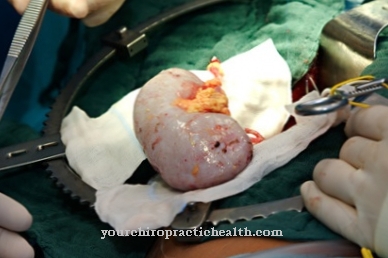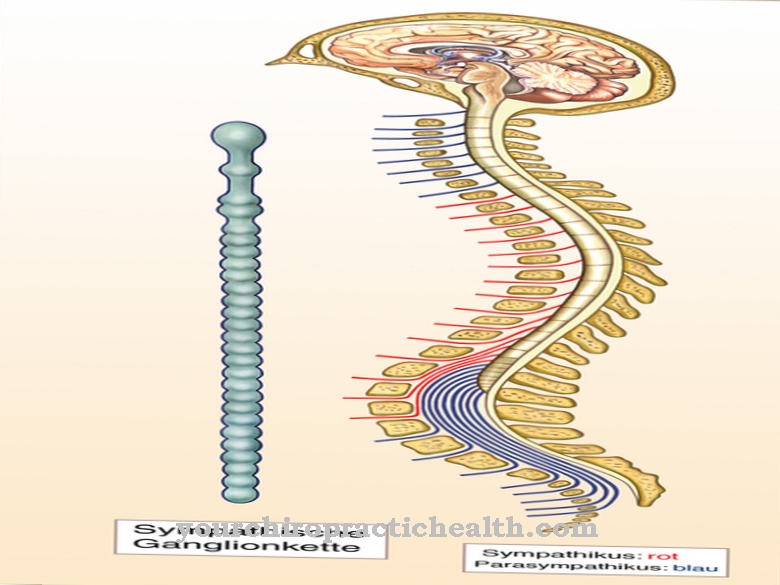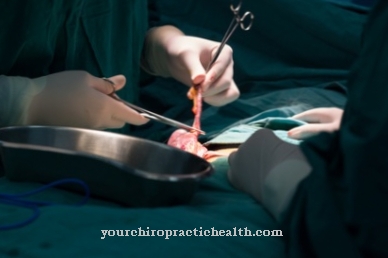In the Transesophageal echocardiography (TEA) an echocardiogram of the heart is done through the esophagus. The investigation is also colloquially called Swallow echo known. Transesophageal echocradiography is used when certain structures in the heart cannot be adequately depicted using external echocardiography of the heart.
What is transesophageal echocardiography?

Depending on the patient's wishes, local anesthesia of the throat is carried out before the examination, since the insertion of the tube into the esophagus can be perceived as uncomfortable. For TEE, the patient has to swallow a transducer. This is attached to a flexible tube, so that a 180 ° C rotation of the transducer is possible. The device is placed near the heart via the esophagus.
There the transducer sends out ultrasonic waves. These are reflected to different degrees by the different tissue structures of the heart. These reflected ultrasound waves are registered again by the transducer and put together into images of the heart structures using complex computing processes in the ultrasound machine's computer. There are various visual display options. The most common is the B-image method, in which the heart and its structures are displayed in two dimensions. The so-called Doppler method can even be used to assess the blood flow in the heart and thus diagnose any valve defects or vascular constrictions that may be present.
Function, effect & goals
Transesophageal echocardiography is always used when the heart representation by transthoracic echocardiography, i.e. echocardiography through the chest wall, is not sufficient for a diagnosis. In particular, the atria of the heart and the main artery, the aorta, cannot be adequately represented by transthoracic echocardiography.
Since the esophagus is located directly behind the heart, very accurate ultrasound images of the heart can be made from here without interfering structures such as the chest, lung tissue or ribs. Transesophageal echocardiography is also used in transthoracic echocardiography in the case of artifacts, i.e. possible technically caused display errors. TEE is the diagnostic procedure of choice for suspected heart valve defects. In this way it can be determined whether one or more of the four heart valves are not closing properly (heart valve insufficiency) or are no longer opening properly due to a narrowing.
Here one speaks of a heart valve stenosis. Transesophageal echocardiography can also be used to assess the point at which these heart valve defects can no longer be treated with medication and when a surgical valve replacement is necessary. The progress and function control is also carried out after the use of an artificial heart valve with the help of the TEE. Atrial fibrillation is one of the most common cardiac arrhythmias and often goes undetected. In contrast to ventricular fibrillation, atrial fibrillation is not directly life-threatening. The accumulation of blood in the atria, which no longer contract due to the fibrillation, can cause blood clots to form, which can then loosen, travel via the arteries to the brain and trigger a stroke there.
In order to detect these blood clots in the atrium at an early stage, a transesophageal echocardiography is also performed if atrial fibrillation is suspected. TEE is also the diagnostic method of choice for endocarditis, i.e. inflammation of the inner skin of the heart. The same applies to the diagnosis and control of untreated aortic aneurysms. An aortic aneurysm is a bulging of the aorta. Aortic aneurysms are often found incidentally and rarely cause pain.
The great danger of these vascular bulges is a rupture with uncontrollable and usually fatal internal bleeding. As with the aortic aneurysms, plaques in the aorta are observed using EET. Plaques are calcium deposits in and on the vessel walls of the arteries. If these dissolve, they can migrate to the brain or other organs, depending on the location, and cause acute vascular occlusion there with drastic consequences such as a stroke or kidney infarction.
Tumors of the heart or the mediastinum (middle layer of the membrane) are also diagnosed with transesophageal echocardiography. Another area of application of the diagnostic method is the early detection of insufficient blood flow in the heart tissue. This reduced blood flow can occur, for example, after a heart attack and entails the risk of tissue death with the consequence of heart failure.
Risks, side effects & dangers
To prevent vomiting, the patient must be fasted when examined - that is, they should not eat or drink for about five to six hours before the transesophageal echocardiography.
If the throat is anesthetized, the patient must not consume any food or liquid for three hours after the examination, as there is a risk of choking. If the patient has also received an injection to calm them down, he is forbidden to drive for the next 24 hours.
Transesophageal echocardiography is a low-risk and well-tolerated diagnostic procedure. In rare cases there are still complications. Vessels, nerves and tissues of the esophagus, larynx or windpipe can be injured when the transducer is inserted. If the patient has loose teeth, damage to the teeth and loss of teeth can occur. The ultrasonic waves can cause cardiac arrhythmias or disorders of the cardiovascular system.
With the additional administration of sedatives, breathing disorders are also observed in rare cases. In addition, hypersensitivity reactions to the anesthetic can occur, which in severe cases lead to anaphylactic shock with the risk of organ failure and suffocation.
EET should not be performed in patients with esophageal varices. Esophageal varices are varicose veins of the esophagus that can occur especially in severe liver disease. If these varicose veins are injured, life-threatening bleeding is the result. Further contraindications for the ultrasound procedure are tumors of the esophagus (esophageal carcinoma) or bleeding in the upper gastrointestinal tract.



























